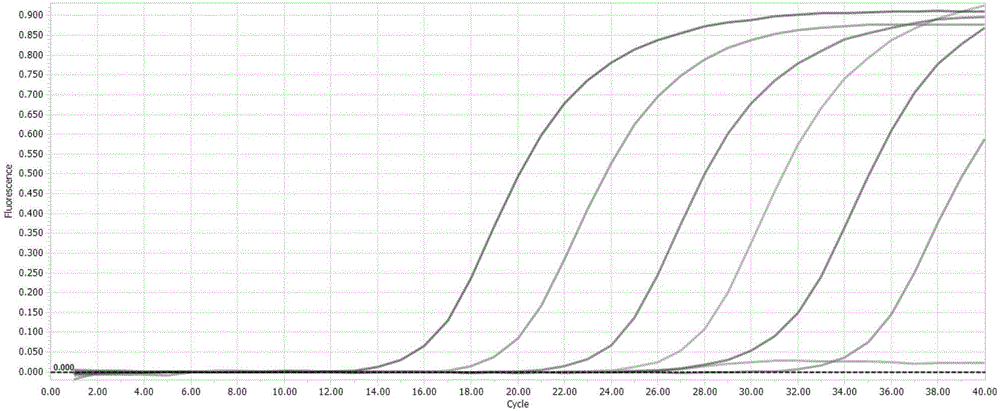Fluorescent quantitative PCR (Polymerase Chain Reaction) kit for detecting Zaire Ebola virus
An Ebola virus, fluorescence quantitative technology, applied in the field of biochemistry, can solve the problems of long time, poor specificity, low sensitivity, etc., and achieve good specificity and high specificity
- Summary
- Abstract
- Description
- Claims
- Application Information
AI Technical Summary
Problems solved by technology
Method used
Image
Examples
Embodiment 1
[0033] Embodiment 1: (preparation kit)
[0034] 1. The composition of the fluorescent quantitative PCR kit for detection of Zaire Ebola virus:
[0035] Upstream primer: 5'-GAACCACATGATTGGACCAAGA-3', 10μM;
[0036] Downstream primer: 5'-TAACTCCAATACCTGCCGGTATC-3', 10μM;
[0037] Fluorescent probe: 5'FAM-TTGTTGATAAAACCCTTCCGGACCAGG-BHQ 3', 10μM;
[0038] Positive standard: pUC57 (Amp + ) recombinant plasmid, the concentration is 10 6 copies / μl.
[0039] Polymerase mixture: containing 5U / μl Taq DNA polymerase and 200U / μl reverse transcriptase, purchased from Beijing Kangrun Chengye Biotechnology Co., Ltd.;
[0040] PCR reaction buffer (5×): purchased from Beijing Kangrun Chengye Biotechnology Co., Ltd.;
[0041] The above nucleic acids were all synthesized by Sangon Bioengineering (Shanghai) Co., Ltd.
[0042] 2. The preparation method of the quantitative positive template is:
[0043] (1) According to the coding gene sequence of the Zaire Ebola virus envelope glycoprotei...
Embodiment 2
[0077] Embodiment 2: (in vitro detection experiment)
[0078] 1. Preparation of the template:
[0079] a. Reagents: RNA extraction kit, purchased from Axygen.
[0080] b. Cultivation and preparation of standard strains:
[0081] Positive standard: 10 6 copies / μl recombinant plasmid;
[0082] Samples to be tested: DH5ɑ engineering bacteria containing recombinant plasmids are used as positive samples, animal cell culture medium of type I dengue virus and Zika virus and DH5ɑ strains without recombinant plasmids are used as mock samples, and the bacteria do not need to extract RNA and use the whole genome as a template ;
[0083] Negative control: deionized water.
[0084] c. RNA extraction: take 200 μl of animal cell culture medium containing type I dengue virus and Zika virus, and extract viral RNA with an RNA extraction kit, with a final volume of 30 μl (for detailed steps, please refer to the kit instruction manual). The extracted RNA template was stored at -80°C for lat...
PUM
 Login to View More
Login to View More Abstract
Description
Claims
Application Information
 Login to View More
Login to View More - R&D
- Intellectual Property
- Life Sciences
- Materials
- Tech Scout
- Unparalleled Data Quality
- Higher Quality Content
- 60% Fewer Hallucinations
Browse by: Latest US Patents, China's latest patents, Technical Efficacy Thesaurus, Application Domain, Technology Topic, Popular Technical Reports.
© 2025 PatSnap. All rights reserved.Legal|Privacy policy|Modern Slavery Act Transparency Statement|Sitemap|About US| Contact US: help@patsnap.com



